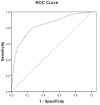Accuracy of general practitioners' assessment of chest pain patients for coronary heart disease in primary care: cross-sectional study with follow-up
- PMID: 20564768
- PMCID: PMC2897083
- DOI: 10.3325//cmj.2010.51.243
Accuracy of general practitioners' assessment of chest pain patients for coronary heart disease in primary care: cross-sectional study with follow-up
Abstract
Aim: To estimate how accurately general practitioners' (GP) assessed the probability of coronary heart disease in patients presenting with chest pain and analyze the patient management decisions taken as a result.
Methods: During 2005 and 2006, the cross-sectional diagnostic study with a delayed-type reference standard included 74 GPs in the German state of Hesse, who enrolled 1249 consecutive patients presenting with chest pain. GPs recorded symptoms and findings for each patient on a report form. Patients and GPs were contacted 6 weeks and 6 months after the patients' visit to the GP. Data on chest complaints, investigations, hospitalization, and medication were reviewed by an independent panel, with coronary heart disease being the reference condition. Diagnostic properties (sensitivity, specificity, and predictive values) of the GPs' diagnoses were calculated.
Results: GPs diagnosed coronary heart disease with the sensitivity of 69% (95% confidence interval [CI], 62-75) and specificity of 89% (95% CI, 87-91), and acute coronary syndrome with the sensitivity of 50% (95% CI, 36-64) and specificity of 98% (95% CI, 97-99). They assumed coronary heart disease in 245 patients, 41 (17%) of whom were referred to the hospital, 77 (31%) to a cardiologist, and 162 (66%) to electrocardiogram testing.
Conclusions: GPs' evaluation of chest pain patients, based on symptoms and signs alone, was not sufficiently accurate for diagnosing or excluding coronary heart disease or acute coronary syndrome.
Figures
Similar articles
-
Accuracy of symptoms and signs for coronary heart disease assessed in primary care.Br J Gen Pract. 2010 Jun;60(575):e246-57. doi: 10.3399/bjgp10X502137. Br J Gen Pract. 2010. PMID: 20529488 Free PMC article.
-
Ruling out coronary heart disease in primary care: external validation of a clinical prediction rule.Br J Gen Pract. 2012 Jun;62(599):e415-21. doi: 10.3399/bjgp12X649106. Br J Gen Pract. 2012. PMID: 22687234 Free PMC article.
-
Prospective multicenter study of quantitative pretest probability assessment to exclude acute coronary syndrome for patients evaluated in emergency department chest pain units.Ann Emerg Med. 2006 May;47(5):447. doi: 10.1016/j.annemergmed.2005.10.013. Epub 2006 Jan 19. Ann Emerg Med. 2006. PMID: 16631984
-
Gender differences in presentation and diagnosis of chest pain in primary care.BMC Fam Pract. 2009 Dec 14;10:79. doi: 10.1186/1471-2296-10-79. BMC Fam Pract. 2009. PMID: 20003406 Free PMC article.
-
Chest pain centers: diagnosis of acute coronary syndromes.Ann Emerg Med. 2000 May;35(5):449-61. Ann Emerg Med. 2000. PMID: 10783407 Review.
Cited by
-
Point-of-Care Troponin T Testing in the Management of Patients with Chest Pain in the Swedish Primary Care.Int J Family Med. 2013;2013:532093. doi: 10.1155/2013/532093. Epub 2013 Jan 10. Int J Family Med. 2013. PMID: 23365746 Free PMC article.
-
The conundrum of acute chest pain in general practice: a nationwide survey in The Netherlands.BJGP Open. 2018 Nov 28;2(4):bjgpopen18X101619. doi: 10.3399/bjgpopen18X101619. eCollection 2018 Dec. BJGP Open. 2018. PMID: 30723804 Free PMC article.
-
How accurate is diagnosis of congenital anomalies made by family physicians?Health Promot Perspect. 2014 Dec 30;4(2):158-64. doi: 10.5681/hpp.2014.021. eCollection 2014. Health Promot Perspect. 2014. PMID: 25648162 Free PMC article.
-
Mechanisms of decision-making in preoperative assessment for older adult prostate cancer patients-A qualitative study.J Surg Oncol. 2020 Mar;121(3):561-569. doi: 10.1002/jso.25819. Epub 2019 Dec 23. J Surg Oncol. 2020. PMID: 31872469 Free PMC article.
-
Diagnostic characteristics and prognoses of primary-care patients referred for clinical exercise testing: a prospective observational study.BMC Fam Pract. 2014 Apr 18;15:71. doi: 10.1186/1471-2296-15-71. BMC Fam Pract. 2014. PMID: 24742057 Free PMC article.
References
-
- Klinkman MS, Stevens D, Gorenflo DW. Episodes of care for chest pain: a preliminary report from MIRNET. Michigan Research Network. J Fam Pract. 1994;38:345–52. - PubMed
-
- Verdon F, Herzig L, Burnand B, Bischoff T, Pecoud A, Junod M, et al. Chest pain in daily practice: occurrence, causes and management. Swiss Med Wkly. 2008;138:340–7. - PubMed
MeSH terms
LinkOut - more resources
Full Text Sources
Medical



